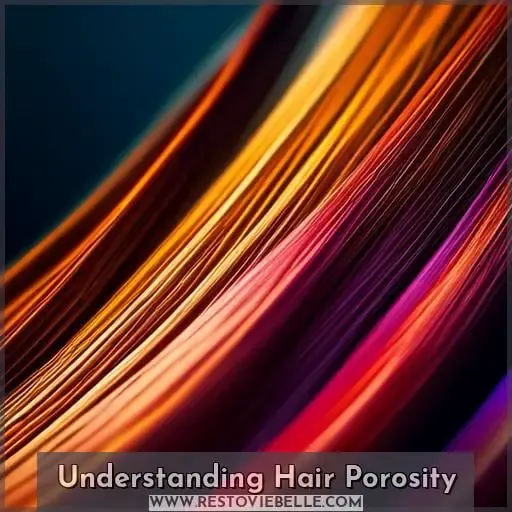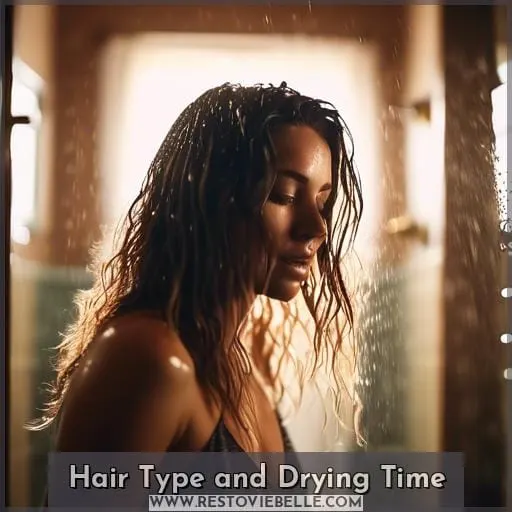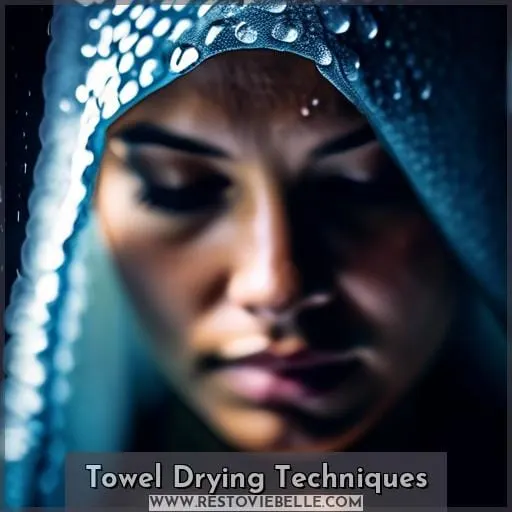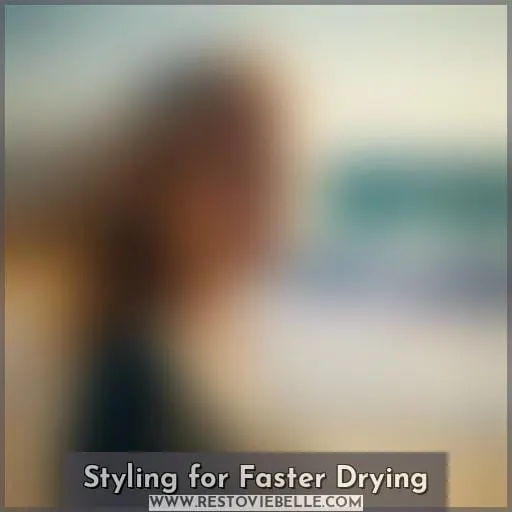This site is supported by our readers. We may earn a commission, at no cost to you, if you purchase through links.
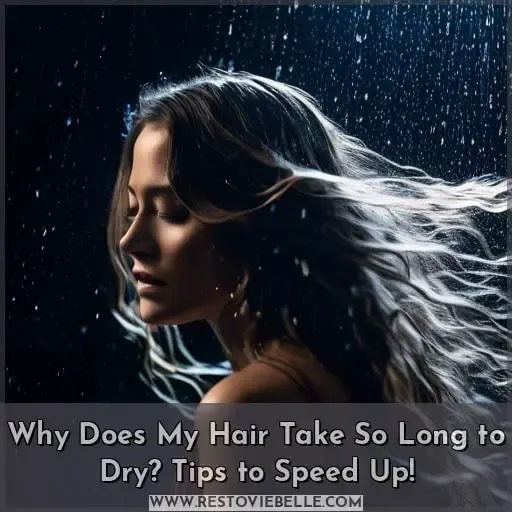 Dive into the mystery of lingering dampness in your locks and discover why your hair takes so long to dry.
Dive into the mystery of lingering dampness in your locks and discover why your hair takes so long to dry.
You’re not alone in the struggle against time-consuming drying sessions. Factors like hair porosity, thickness, and the products you use all play a pivotal role.
Embrace the quest for quicker drying techniques and innovative products designed to expedite the process, satisfying your craving for efficiency and the allure of innovation.
Let’s unravel the secrets to a faster hair drying experience, tailored just for you.
Your hair takes longer to dry due to factors like thickness, porosity, and styling products that hinder airflow, making it essential to adjust drying techniques and consider hair type.
Table Of Contents
- Key Takeaways
- Understanding Hair Porosity
- Hair Type and Drying Time
- Hydration and Product Use
- Towel Drying Techniques
- Enhancing Drying With Products
- Styling for Faster Drying
- Frequently Asked Questions (FAQs)
- Can certain hair treatments or dyes affect the drying time of hair?
- How does the climate or weather influence hair drying time?
- Are there any specific dietary factors that can impact the moisture levels and drying time of hair?
- Can hormonal changes or medical conditions lead to variations in hair drying time?
- Does the hardness or softness of water used to wash hair affect its drying time?
- Conclusion
Key Takeaways
- Hair porosity significantly influences drying time, with high porosity hair drying faster due to its ability to absorb moisture quickly, whereas low porosity hair takes longer because it resists moisture absorption.
- The thickness, density, and curl pattern of hair affect its drying time, with thicker, denser hair and tighter curls taking longer to dry due to reduced airflow and more hair to dry.
- The use of hydrating products and treatments can extend drying time by retaining more moisture in the hair, while quick-dry sprays and certain styling techniques can help reduce it.
- Adjusting hair care routines to match hair type, including porosity, thickness, and curl pattern, can improve drying efficiency and overall hair health.
Understanding Hair Porosity
If you’ve ever wondered why your hair takes ages to dry, it might be time to look into hair porosity.
This trait is all about how well your hair can soak up and hold onto moisture, which plays a big role in drying times.
By figuring out if your hair has high, medium, or low porosity, you can tailor your hair care routine to better suit your locks, potentially speeding up those long drying times.
High Vs. Low Porosity
Your hair’s porosity is a key factor in understanding why it may take a long time to dry, as it determines your hair’s ability to absorb and retain moisture. Hair porosity is categorized into three levels: low, normal, and high. Low porosity hair has tightly bound cuticles that resist moisture absorption and take longer to dry, while high porosity hair has more open cuticles that absorb moisture quickly but also lose it rapidly, which can lead to faster drying but also more frizz and dryness.
To determine your hair’s porosity, you can perform a simple test at home by placing a strand of clean hair in a cup of water to see if it floats (low porosity) or sinks (high porosity). Understanding whether you have low or high porosity hair can help you choose the right products and techniques to manage your hair’s moisture levels and drying time effectively.
Here are four key points to consider regarding hair porosity:
- Moisture Absorption: High porosity hair can absorb moisture quickly, but struggles to retain it, leading to potential hair damage.
- Sealing Moisture: For low porosity hair, using the right techniques and products is crucial for sealing moisture into the hair shaft.
- Product Penetration: Low porosity hair may resist product penetration, making it important to apply products to damp hair for better absorption.
- Hair Integrity: Maintaining hair integrity involves choosing products that match your hair’s porosity, preventing over-drying or excessive moisture.
Testing for Porosity
Transitioning from understanding the differences between high and low porosity hair, determining your hair’s porosity through testing is a crucial next step. Conducting a simple experiment at home, such as the float test, can provide insights into how your hair retains moisture.
By shampooing and rinsing your hair to eliminate any product buildup, then placing a clean, dry strand into a glass of water, you’ll observe if it sinks or floats. This test reveals whether you have low, normal, or high porosity hair, which in turn affects how you should care for and style your hair to maintain its health and appearance.
Here’s a quick reference table for porosity testing methods and their implications:
| Porosity Level | Float Test Result | Hair Care Implication |
|---|---|---|
| Low Porosity | Strand floats | Resists moisture absorption, requires lighter products |
| Normal Porosity | Strand sinks slowly | Balanced moisture retention, easier to manage |
| High Porosity | Strand sinks immediately | Loses moisture quickly, needs more care and protection |
Understanding your hair’s porosity is essential for selecting the right hair products and establishing an effective hair care routine. High porosity hair may require protein treatments to strengthen the cuticle, while low porosity hair benefits from lighter, hydrating products.
When it comes to heat styling, it’s important to use heat protectants and moderate temperatures to prevent further damage to the hair’s structure.
Hair Type and Drying Time
If you’ve ever wondered why your hair seems to take an eternity to dry, you’re not alone.
The thickness of your hair, its curl pattern, and overall density are key factors that influence drying time.
Understanding these aspects of your hair type can help you adapt your drying routine for more efficient results.
The Role of Thickness
As we delve into the role of hair thickness in drying time, it’s important to recognize that the density and texture of your strands play a significant part in how quickly you can go from wet to wonderfully styled.
Thick hair, with its high density and weight impact, inherently takes longer to dry compared to hair with low density. The porosity influence is also crucial; low-porosity hair retains water, extending drying time, while high-porosity hair allows moisture to escape more readily.
To manage this, hair care products are designed specifically for thick hair, aiming to improve hair drying time while maintaining hair health. Incorporating hair care tips and tricks, such as using microfiber towels and applying products to damp hair, can aid in achieving a faster and healthier drying process.
The Impact of Curl Pattern
One must consider the unique challenges that come with different curl patterns when discussing hair drying times.
Curl pattern significantly affects airflow and drying time; tighter curls and coils often mean slower drying because the air doesn’t circulate as freely through the hair as it does with straighter types.
If you’re using a diffuser or air-drying, it’s important to adjust your expectations and techniques accordingly to protect your hair’s natural pattern and health.
Density’s Effect
In accordance with your hair’s density, you’ll find that the more strands per square inch you have, the longer the drying process will take due to the increased volume of hair that needs to dry.
- Density’s Impact: High-density hair, with its abundant strands, naturally takes longer to dry. This is because there’s simply more hair to deal with, which can slow down the evaporation of water.
- Density’s Importance: Understanding your hair’s density is crucial for managing drying times effectively. It guides you in selecting the right hair care products and drying techniques that cater specifically to your hair’s needs.
- Density’s Consequences: For those with high-density hair, adopting strategies like using microfiber towels or section drying can significantly improve the drying process, making it more manageable and less time-consuming.
Hair care for all hair densities involves recognizing the unique challenges posed by your hair’s volume and adjusting your routine accordingly. Whether you’re dealing with high, medium, or low-density hair, the goal is to find a balance that promotes healthy hair while minimizing drying time.
Hydration and Product Use
When you’re wondering why your hair takes ages to dry, consider the hydration and products you’re using.
Moisturizing products can actually extend drying time because they’re designed to keep your hair hydrated. To counteract this, apply treatments and conditioners to damp hair after towel-drying for more efficient absorption and a quicker dry.
Moisturizing Products’ Effects
After discussing the role of hair type in drying time, it’s important to consider how hydration and product use can further influence this process. If you’re applying moisturizing products to your hair, you might notice that your hair takes longer to dry because these products are designed to seal in moisture, which can slow down the evaporation of water from your strands.
| Product Type | Purpose | Effect on Drying Time |
|---|---|---|
| Hair Serum | Adds shine and smooths | May increase drying time due to coating strands |
| Hair Oils | Seals in moisture | Can slow drying by locking in water |
| Deep Conditioning Treatments | Restores hair health | Longer drying due to intense moisture retention |
| Hydration Strategies (e.g., LCO method) | Layers moisture | Increases time due to multiple product layers |
| Quick-Dry Sprays | Speeds up drying | Reduces time by accelerating water evaporation |
Understanding your hair’s porosity levels is crucial for effective hydration strategies. Low porosity hair has tightly bound cuticles, making it resistant to absorbing moisture and thus, takes longer to dry.
Conversely, high porosity hair absorbs moisture quickly but also loses it rapidly, leading to faster drying times but also potentially drier hair. To maintain hair health and hydration, it’s essential to choose products like hair serums and oils wisely, considering how they interact with your hair’s unique characteristics.
Application Techniques
Transitioning from discussing the effects of moisturizing products on hair drying time, let’s focus on how you apply these products, as this can significantly influence the drying process.
If you’re aiming for quicker drying times, consider applying lighter products or those designed for rapid absorption to damp hair.
Towel Drying Techniques
To expedite drying your hair:
- Use a microfiber towel or a cotton T-shirt for efficient moisture absorption.
- Prevent frizz during this process.
- Employ a wide-tooth comb to enhance airflow and speed up drying.
- Be gentle when towel drying to protect hair strands from damage.
- Double newline for clarity between these points.
Microfiber Towels
Amidst the myriad of towel options, choosing a microfiber towel for your hair-drying routine can significantly expedite the process due to its superior absorbency and gentle nature on hair strands.
Microfiber towels stand out for their ability to reduce drying time, minimize hair breakage, and prevent frizz, making them an essential addition to your hair care routine. These towels are designed with tightly woven fibers that are incredibly effective at removing excess water from your hair, thereby speeding up the drying process without the harsh rubbing or heat that can damage hair.
Additionally, their lightweight and compact nature makes them convenient for both home use and travel. By integrating a microfiber towel into your regimen, you’re not only saving time but also promoting healthier hair through gentler drying methods.
T-Shirt Drying
Switching to a cotton T-shirt for drying your hair can significantly cut down on frizz and damage.
- Frizz Control: Cotton fabric is smoother than terrycloth, reducing friction and thus controlling frizz.
- Friction Reduction: T-shirts create less friction, which means less breakage and healthier hair.
- Gentle Drying: The softness of a cotton T-shirt is gentle on your strands, especially beneficial for curly or coily hair.
- Absorbency: While not as absorbent as microfiber, a T-shirt will still effectively rough dry hair, absorbing excess water without over-drying.
Be patient with the process, as it may take a bit longer than using a traditional towel, but the benefits for your hair’s health and appearance can be well worth it. Choose the right towel material for your hair type and drying preferences to optimize your hair care routine.
Enhancing Drying With Products
If you’re wondering why your hair takes ages to dry, you might want to consider the products you’re using.
Leave-in conditioners and quick-dry sprays can be game-changers. These products not only help with detangling and managing frizz but can also significantly reduce drying time, making your routine more efficient.
Leave-in Conditioners
After drying your hair with a microfiber towel or t-shirt to minimize damage, you can enhance the drying process by applying a leave-in conditioner. This step not only helps with moisture retention but also primes your locks for styling.
When you’re aiming for that perfect look, the right leave-in application can make all the difference. It’s not just about slathering on any product; it’s about choosing one that complements your hair’s unique needs.
For those with curly hair, a product that promises curl definition without sacrificing volume is key. If you’re dealing with high porosity hair, look for deep conditioning formulas or hair masks that can offer the intensive hydration your strands crave.
And don’t overlook the power of a quick-dry spray to expedite the process while keeping your hair’s shape intact. Remember, the goal is to saturate your hair with the right balance of moisture and care, setting the stage for a good hair day, every day.
Quick-Dry Sprays
One might find that using a quick-dry spray can significantly reduce the time it takes to dry your hair, as these products contain ingredients that evaporate quickly.
If you’re looking to expedite your hair drying process, consider incorporating quick-dry sprays into your routine. These sprays work by accelerating the evaporation of water from your hair, which can be particularly useful when you’re in a rush.
For those with voluminous or curly locks, root-lifting sprays and curl-enhancing creams can also aid in faster drying while maintaining your hair’s natural texture.
Remember to use heat protectants to safeguard your hair from heat damage during blow drying. This hair care advice is applicable to all hair types, ensuring that your hair blow dry is efficient without compromising hair health.
Styling for Faster Drying
When it comes to styling your hair for faster drying, understanding the right techniques and tools is crucial.
Rough drying, which involves using your fingers to tousle your hair while blow-drying, focuses the airflow at the roots to remove excess moisture quickly.
Additionally, using a diffuser attachment can significantly enhance your curls and add volume without compromising the hair’s natural texture.
These methods not only speed up the drying process but also contribute to a healthier and more defined hairstyle.
Rough Drying
Your hair’s drying time can be significantly reduced by mastering the technique of rough drying, which involves using your fingers to tousle and dry your hair, focusing on the roots for added volume.
This method not only accelerates the drying process but also enhances curl definition and volume, especially when paired with a heat protectant to shield your strands from damage.
For those with coarse hair, rough drying can minimize breakage and preserve hair health. As part of your hair care guide, consider incorporating friction reduction techniques and using products suitable for all hair porosities and lengths to ensure hair protection during drying.
Using Diffusers
Efficiency in styling is crucial for those with curly hair, and utilizing a diffuser attachment can significantly expedite the drying process while enhancing your curls’ natural beauty and volume.
When you’re aiming to avoid heat damage but still desire well-defined curls and frizz control, a diffuser becomes an indispensable tool. It’s a balancing act—managing the heat to protect your hair while achieving the desired style.
By incorporating the right styling products, you can ensure that your hair care caters to all hair goals and types. Remember, hair care for all hair styles is about understanding your hair’s needs and adapting your techniques accordingly.
Whether you’re looking to seal in moisture or simply tame hair frizz, the diffuser attachment is a versatile ally in your hair styling arsenal.
Frequently Asked Questions (FAQs)
Can certain hair treatments or dyes affect the drying time of hair?
Yes, hair treatments and dyes can significantly affect drying time.
Dyes often dry out strands by opening the cuticle layer, letting moisture escape, making hair dry and brittle.
Treatments using heat can also damage hair surfaces, altering moisture content and drying time.
How does the climate or weather influence hair drying time?
Humid, hot, or windy conditions can significantly affect your hair’s drying time.
High humidity can cause hair to absorb moisture from the air.
Wind can remove moisture, both altering drying times.
Are there any specific dietary factors that can impact the moisture levels and drying time of hair?
A diet lacking in essential fatty acids can lead to dry, brittle hair.
Omega-3 and omega-6 fatty acids play a crucial role in maintaining hair moisture levels.
This can impact drying time.
Can hormonal changes or medical conditions lead to variations in hair drying time?
Yes, hormonal changes or medical conditions can indeed lead to variations in hair drying time. They may affect hair texture, growth, and oil production. These factors influence moisture retention and drying.
Does the hardness or softness of water used to wash hair affect its drying time?
Diving into the heart of your query, the water’s hardness indeed plays a pivotal role in the drying time of your hair.
Imagine your hair as a thirsty sponge in a desert, seeking moisture. Hard water, laden with minerals like calcium and magnesium, acts as a barrier, cloaking your hair in an invisible shield that repels the very moisture it seeks.
This mineral buildup not only makes your hair feel like a parched, brittle tumbleweed but also hampers your efforts to hydrate it, leading to longer drying times.
Soft water, on the other hand, is like a gentle rain, easily absorbed by your hair, leaving it more pliable and quicker to dry. In essence, the softer the water, the less it fights against your hair’s natural tendencies, allowing for a smoother, faster drying process.
Conclusion
Coincidentally, the very factors that make your hair unique also dictate why it takes so long to dry.
Understanding your hair’s porosity, thickness, and how various products interact with it can be a game-changer in your drying routine.
Whether you’re using microfiber towels to wick away moisture or applying quick-dry sprays to expedite the process, adapting these techniques to your specific hair type can significantly cut down drying time.
So, next time you’re wondering why your hair takes so long to dry, consider these insights and adjust your routine for better, faster results.
